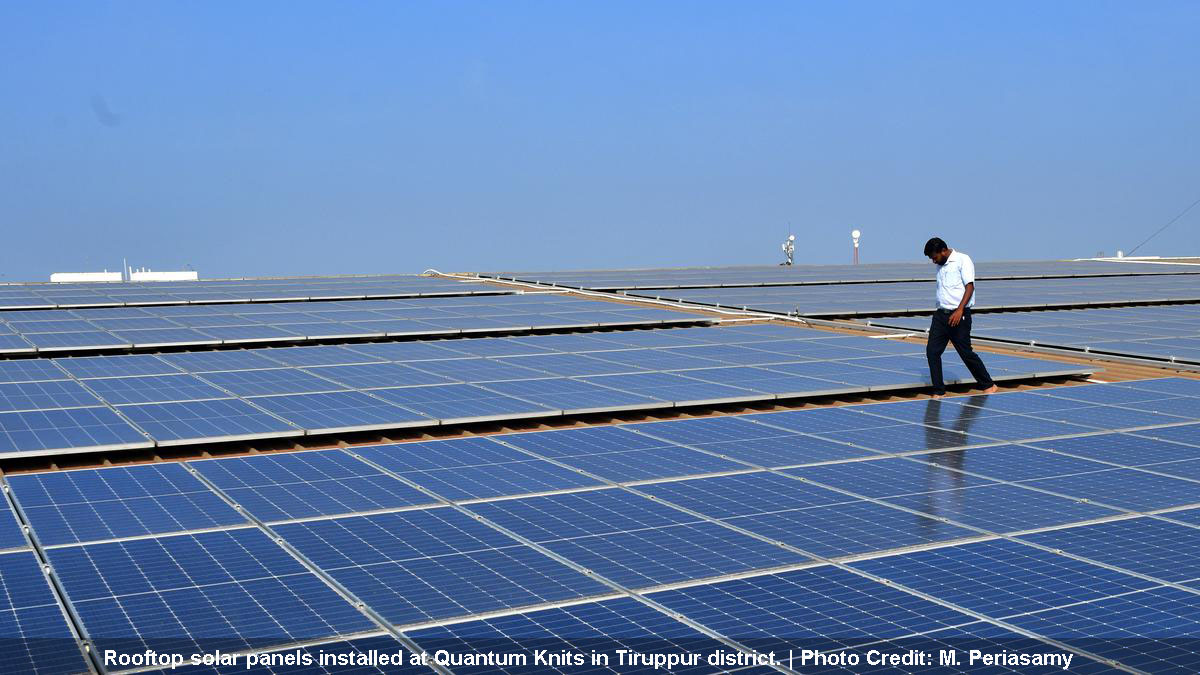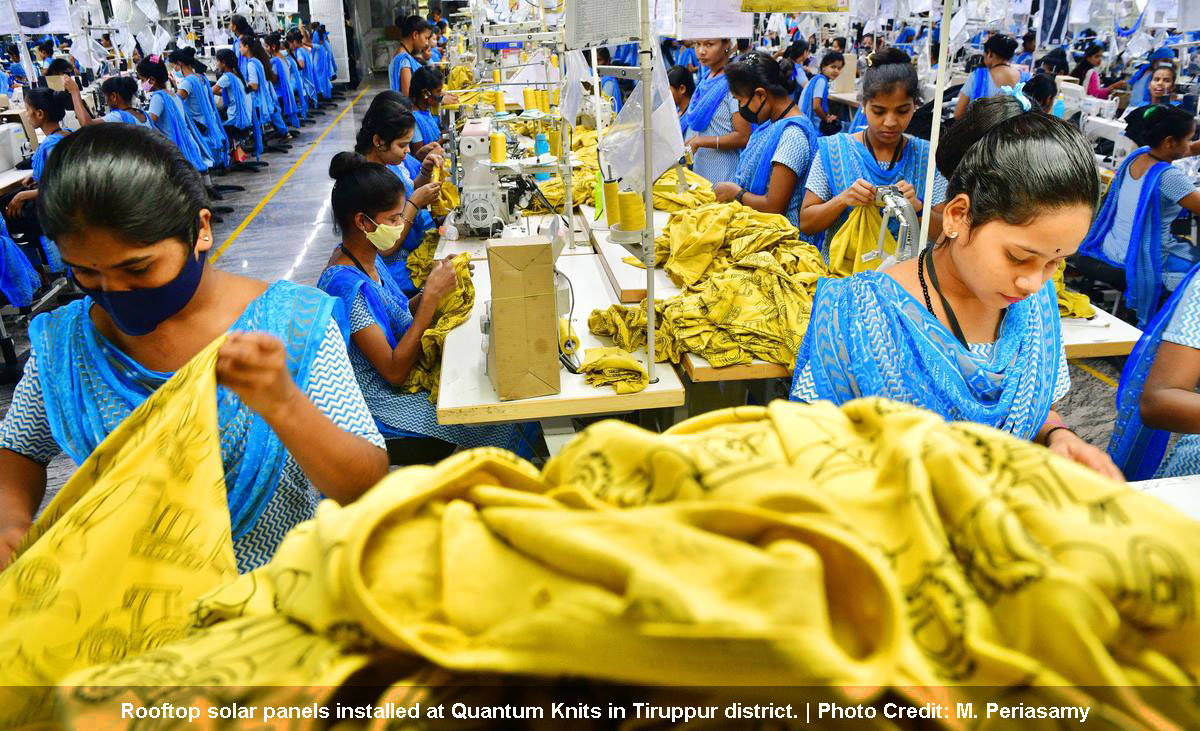
Category: General
Country: India
Region: South Asia
There is palpable concern in India’s textile sector, dominated by small businesses, about the impact of new rules like EU’s CBAM and complying with ESG norms; there is also a recognition this might be the moment to attempt a paradigm shift in sourcing, production, pricing and supply processes
By M Soundariya Preetha
31st December, 2023 07:02 am
Updated January 01, 2024 12:48 pm IST
Coimbatore: The textile and apparel sector in Tamil Nadu contributes more than 50% of installed renewable energy capacity in the State; nearly 300 textile processing units in Tiruppur are connected to common effluent treatment plants with zero liquid discharge; in Panipat, Haryana, open-end spinners use only recycled fibre; and India recycles almost 90% of its used PET bottles into fibre. These are among some sustainable practices that India’s textile and clothing sector has invested in over the past two decades.
Now, as the European Union (EU’s) moves towards implementing its environmental, social, and governance (ESG) goals and the European Green Deal takes effect in 2026, several global brands are insisting on sustainable production and supply chains.
There is palpable concern in India’s textile sector, dominated by small businesses - the Micro, Small and Medium Enterprises (MSMEs), about the impact new rules like EU’s Carbon Border Adjustment Mechanism (CBAM) would have, aside from complying with the ESG standards. But there is also recognition that this might well be the moment to attempt a paradigm shift in sourcing, production, pricing and supply processes, to cement the sector’s position as a top global supplier.
‘ESG a significant disruptor’
Acknowledging ESG demands of overseas buyers as “significant disruptors”, Tamanna Chatuurvedi, deputy secretary general, Apparel Export Promotion Council (AEPC), says it is a “do or die situation” for India’s textile and apparel sector.
She says exporters can leverage benefits of India’s potential free-trade agreement with the EU only if they invest in sustainability. Ms. Chatuurvedi adds this also requires considerable documentation of various sustainable and inclusive social practices the sector has already achieved.
Indeed, some of it, like the social indicator of employing rural women in large numbers, have helped the industry.

While major garment exporters have begun releasing annual sustainability reports, clusters like Tiruppur are showcasing their collective green footprints. At Heimtexil in Frankfurt next month, exporters from Karur will showcase carbon credit data and sustainable home textile products and the AEPC plans curated shows of sustainable garments. Representatives of global clothing brands have already begun visiting garment and fast fashion clusters, to deliberate on ESG compliances.
A leading garment exporter in Coimbatore said ESG norms compliance is mandatory “to just continue to be a supplier.”
India exports 16% of its cotton textiles to the EU, 40% of its synthetic fabric and about a third - 28% of the country’s total apparel exports are to European countries.The Ministry of Textiles has formed an ESG task force and is considering supportive interventions for the industry; industrial associations are joining hands with organisations that will enable exporters to put systems in place, document the measures taken, and get the required certifications; the Cotton Textiles Export Promotion Council (Texprocil) is promoting Indian cotton brand Kasturi that comes with traceability; and some of the financial institutions are reaching out to MSMEs to fund green and sustainable projects.
Despite these positive strides, significant hurdles remain for the sector to meet various mandates as almost 90% of garment exporters are MSMEs, and 50%-60% of cotton and synthetic exporters as well. And, these compliances and documentation come with additional costs, thinning the units’ margins. Moreover, individual European countries are coming out with their own codes.
Rakesh Mehra, Chairman, Confederation of Indian Textile Industry (CITI), pointed to challenges relating to complying with supply chain sustainability norms
“Orders will go to those who are compliant. But, big companies may not manufacture products that smaller ones do,” he said.
Even among different parameters that constitute ESG, challenges remain. SK Sundararaman, chairman of Southern India Mills’ Association, points out that labour issues vary in each textile/garment producing State. “ESG talks about ‘living wages’. It will be different in each State, leading to difference in labour costs,” he says.
Another example is the use of recycled fibres. Tiruppur is already seeing imports of hosiery waste from Bangladesh as demand increases for recycled fibre. But the quality of regenerated cotton is not on a par with fresh cotton and so it can only be blended in specific quantities, say garment producers.
Unsupportive global buyers
According to P. Gopalakrishnan, chairman of Handloom Export Promotion Council, overseas buyers are helping the suppliers with inputs to meet mandates and currently, they are insisting on norms only with tier-one suppliers. But he says, norm compliance increases the product price significantly, and buyers are not supportive. While manufacturers, irrespective of the size of the company, in the supply chain must invest to meet ESG norms, only some global brands are ready to pay a higher price for these products, say fast fashion exporters.
The Synthetic and Rayon Textiles Export Promotion Council (SRTEPC) is advocating exemption for MSMEs from ESG norms in the proposed FTA with the EU. The EU has exempted its own MSMEs from ESG norms and the Indian government must ask for a similar treatment for India’s textiles producers, they say. The Tiruppur Exporters Association is seeking incentives for sustainability efforts. It is also asking for a separate Harmonised System codes for export of sustainable products.
There are other concerns, like the increasing use of recycled or regenerated meterial across the production process, but domestic consumers are not made aware of such developments. Retailers do not sell them in the local market as sustainable products, reducing a premium price from domestic consumers.
Sanjay Jain, Managing Director of TT Limited and former chairman of CITI, says his company recently came manufactured garments with 100% recycled fibres for domestic consumers, but received no premium for such products. Yet, with global emphasis on sustainability, use of recycled fibres will increase by 7% -10% of total fibres consumed in India in the next 10 years, he reckons.
Bhadresh M. Dodhia, chairman of SRTEPC, and Mr. Jain called for mandates for domestic retailers too to sell at least a percentage of sustainable products to signal India’s commitment to ESG norms.
Exporters say another fall out of the ESG norms implementation would be reduction in the fashion seasons. Some brands have more than 10 fashion seasons in a year and this is likely to reduce with emphasis on circularity and reuse.
“A lot (of the norms) is driven by retailers and brands. They are also seeing the price viability. But, low prices should not be confused with low ethics or transparency. Norms are about increasing the life cycle of products and raw materials”, said the ESG head of a global sourcing company not wishing to be named.
Exporters also apprehend the possible linking of ESG norms to trade negotiations. “The world is moving towards recycling. However, when policies related to social and environment are linked to trade policies, the could possibly become barriers,” said Siddhartha Rajagopal, Executive Director of Texprocil.
Courtesy: TheHindu.com
Copyrights © 2025 GLOBAL TEXTILE SOURCE. All rights reserved.